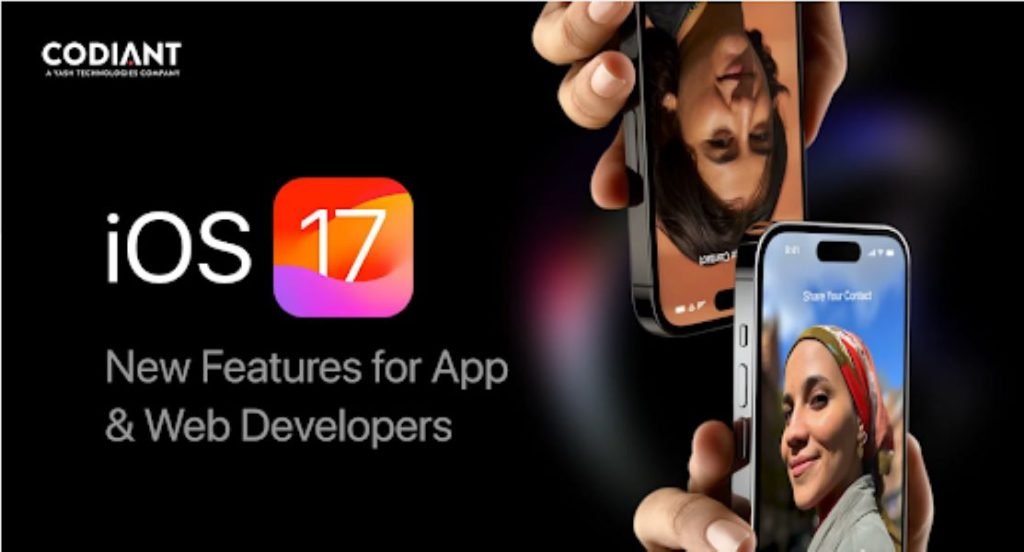With the release of iOS 17 on September 18, iPhone app developers are in for a treat as Apple introduces a host of exciting features, tools, and development environments to revolutionize the app development experience. Let’s explore some of the highlights of the iOS 17 update and what’s in store for iPhone app developers.
Interactive widgets for different Apple devices
iOS app developers can now use WidgetKit to create animated, attractive, and interactive widgets for users on every Apple device.
The dawn of iOS 17 brings a wave of transformation. A few simple adjustments during the rebuilding process ensure that existing widgets seamlessly blend into the landscape of StandBy on iPhones, grace the Lock Screen on iPads, and find a home on the desktop of Mac.
SwiftUI, with its adaptive capabilities, goes beyond aesthetics, dynamically adjusting widget colours and spacing based on the context in which they appear, extending their utility across diverse platforms.
It’s easier than ever to create intuitive apps with Xcode 15
With the release of iOS 17, developers can now access the game-changing capabilities of Xcode 15. This dynamic platform opens the door for developers to explore a suite of new and exciting features to supercharge the iOS app development process. The main purpose of Xcode 15 is to help developers see designing and coding as not just tasks but exciting processes.
But that’s not all the testing process has also been streamlined using Git staging, a companion that allows you to craft your next commit without diverting your focus from the code at hand. Testing becomes a journey of exploration with redesigned test reports, complete with video recordings that offer a deeper understanding of your app’s performance.
Seamlessly deliver high-quality in-app purchase experiences
The introduction of StoreKit views represents a notable enhancement in facilitating secure merchandising experiences for in-app purchases and subscriptions across the spectrum of Apple platforms. Remarkably simplifying the process, developers can now present comprehensive information, including service description, pricing, and duration, to users with a mere single line of code.
This improvement aligns with broader updates to the App Store Server API and includes advancements in StoreKit testing within Xcode, the Apple sandbox environment, and TestFlight. Consequently, developers can expect an augmented and refined experience in the development, testing, and deployment phases of in-app purchases on Apple platforms.
New and exciting advancements in in-app shortcuts
Upon the adoption of App Shortcuts, the pivotal features of your application are seamlessly presented in Spotlight when users search for your app. A revamped design enhances the accessibility of your app’s shortcuts, rendering the execution of key functionalities more straightforward. The integration of new natural language capabilities empowers users to execute shortcuts through voice commands, providing an added layer of flexibility.
Furthermore, a redesigned Shortcuts app consolidates the discovery and execution of your application’s key features, offering users a centralized and convenient platform for streamlined accessibility.
Privacy updates for app store submissions
Apple introduced new privacy manifests and signatures for SDKs (third-party software development kits) designed to provide developers with a clearer understanding of how third-party SDKs utilize data and secure software dependencies.
With the release of iOS 17, Apple also revealed that come spring 2024, a new mandate would come into effect. For developers submitting either a new app or an update that integrates a third-party SDK commonly found in the App Store ecosystem, the inclusion of the privacy manifest for the SDK would be obligatory. It’s a clear signal that Apple is heightening its emphasis on privacy, pushing developers to be more accountable and transparent in their use of third-party tools. The privacy updates also introduced new use cases for APIs that require an approved reason during app submissions.
Example of Privacy Manifest- Source
New API rules that require reasons
Following the launch of iOS 17, Apple has introduced a significant update to the App Store Connect submission process. When applying App Store Connect that utilizes an API —this includes third-party SDKs—developers must provide an approved reason in the app’s privacy manifest. Also, the reason should accurately depict how the app utilizes the API, providing users with a clear understanding of the data-handling practices employed.
In response to insights gleaned from developers around the globe, Apple has expanded the list of approved reasons. This expansion is a direct result of understanding that developers may have unique use cases, not covered by the initial set of approved reasons. Apple acknowledges that certain functionalities might directly benefit users but might not neatly align with the existing categories.
iOS 17 and Core ML updates for developers
The latest advancements in Core ML, showcased in the newest iOS update, bring a suite of powerful tools to the fingertips of developers, empowering them to create more efficient and dynamic machine-learning experiences within their apps. This introduces new features and capabilities that elevate the possibilities for app developers.
1. Optimization tools for Core ML: Core ML now comes equipped with advanced optimization tools that cater to key aspects such as compression and faster loading. These enhancements enable developers to streamline the integration of machine learning models into their apps.
2. Create ML advancements: The Create ML framework, an integral part of the machine learning toolkit, introduces notable improvements. Developers can now leverage multi-label classification for enhanced model understanding, conduct interactive model evaluations, and utilize new APIs for custom training data augmentations.
3. Vision framework enhancements: The Vision framework takes a significant leap forward with more robust image segmentation and the addition of 3D depth information for human body pose. These advancements enhance the accuracy and versatility of computer vision applications, offering developers the tools to create more immersive and realistic experiences.
4. VisionKit integration: VisionKit, an extension of the Vision framework, makes it effortless for developers to integrate Visual Lookup and subject-lifting experiences into their apps. This opens up new possibilities for interactive and engaging applications, where users can explore and understand the visual content in innovative ways.
5. Natural language framework updates: The Natural Language framework undergoes enhancements that bolster the understanding of multilingual text. The introduction of new transformer-based embedding models ensures more nuanced and context-aware language processing, providing developers with the tools to create applications that seamlessly navigate diverse linguistic contexts.
6. Speech framework customization: The Speech framework now allows for custom vocabulary in speech recognition. This means developers can tailor speech recognition models to better understand specialized terminologies or unique phrases, ultimately personalizing the user experience in applications reliant on voice interactions.
Advanced accessibility features
iOS 17 places a strong emphasis on accessibility, offering developers tools and features that enable them to create apps that are more inclusive, personalized, and user-centric for all users, including those with cognitive disabilities.
Advanced speech synthesis
Developers can now craft custom experiences, particularly beneficial for users with cognitive disabilities. This feature adds a personalized touch to spoken guidance within apps.
Accessibility APIs for improved UI tests
Enhancements to accessibility APIs not only contribute to a more inclusive user experience but also streamline UI testing for application developers.
Advances in UI frameworks
Improved UI frameworks simplify the creation of rich and accessible interfaces. Developers can design visually appealing apps that are also user-friendly for individuals with diverse accessibility needs.
Conclusion
iOS 17 brings about a lot of exciting opportunities for iPhone app developers and provides the creative freedom a developer needs to create robust, more efficient, user-friendly, and innovative applications. Businesses seeking to capitalize on these opportunities should consider hiring iOS app developers with the appropriate skill sets and knowledge of the
latest iOS 17 updates.


